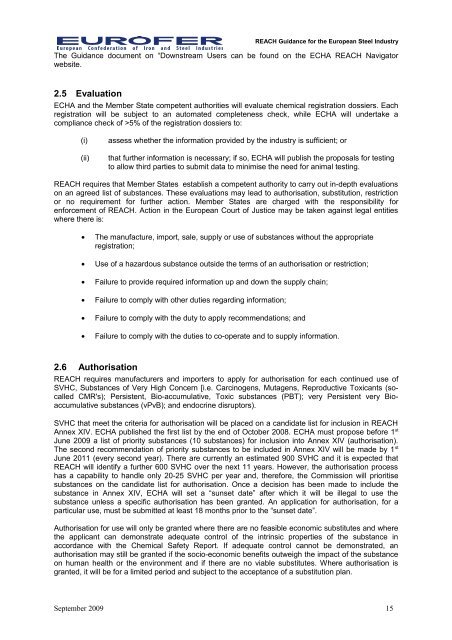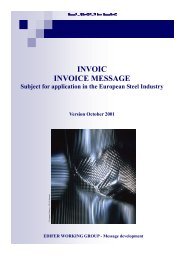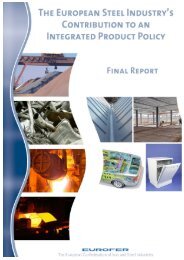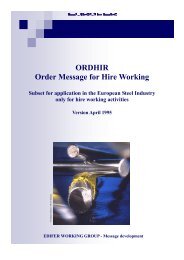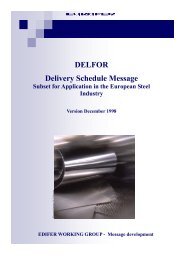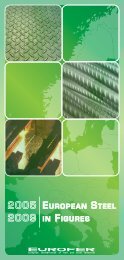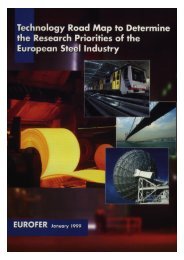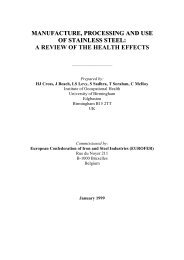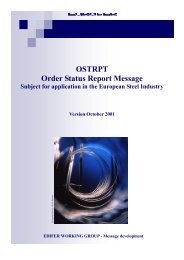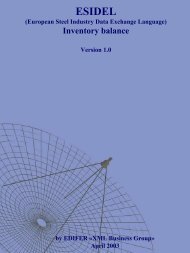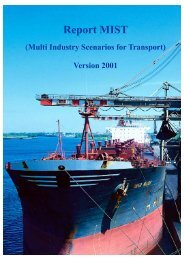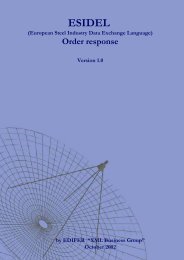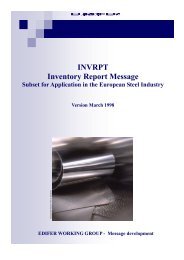EUROFER REACH guidance for the European Steel Industry. 09.09 ...
EUROFER REACH guidance for the European Steel Industry. 09.09 ...
EUROFER REACH guidance for the European Steel Industry. 09.09 ...
Create successful ePaper yourself
Turn your PDF publications into a flip-book with our unique Google optimized e-Paper software.
<strong>REACH</strong> Guidance <strong>for</strong> <strong>the</strong> <strong>European</strong> <strong>Steel</strong> <strong>Industry</strong><br />
The Guidance document on “Downstream Users can be found on <strong>the</strong> ECHA <strong>REACH</strong> Navigator<br />
website.<br />
2.5 Evaluation<br />
ECHA and <strong>the</strong> Member State competent authorities will evaluate chemical registration dossiers. Each<br />
registration will be subject to an automated completeness check, while ECHA will undertake a<br />
compliance check of >5% of <strong>the</strong> registration dossiers to:<br />
(i) assess whe<strong>the</strong>r <strong>the</strong> in<strong>for</strong>mation provided by <strong>the</strong> industry is sufficient; or<br />
(ii) that fur<strong>the</strong>r in<strong>for</strong>mation is necessary; if so, ECHA will publish <strong>the</strong> proposals <strong>for</strong> testing<br />
to allow third parties to submit data to minimise <strong>the</strong> need <strong>for</strong> animal testing.<br />
<strong>REACH</strong> requires that Member States establish a competent authority to carry out in-depth evaluations<br />
on an agreed list of substances. These evaluations may lead to authorisation, substitution, restriction<br />
or no requirement <strong>for</strong> fur<strong>the</strong>r action. Member States are charged with <strong>the</strong> responsibility <strong>for</strong><br />
en<strong>for</strong>cement of <strong>REACH</strong>. Action in <strong>the</strong> <strong>European</strong> Court of Justice may be taken against legal entities<br />
where <strong>the</strong>re is:<br />
• The manufacture, import, sale, supply or use of substances without <strong>the</strong> appropriate<br />
registration;<br />
• Use of a hazardous substance outside <strong>the</strong> terms of an authorisation or restriction;<br />
• Failure to provide required in<strong>for</strong>mation up and down <strong>the</strong> supply chain;<br />
• Failure to comply with o<strong>the</strong>r duties regarding in<strong>for</strong>mation;<br />
• Failure to comply with <strong>the</strong> duty to apply recommendations; and<br />
• Failure to comply with <strong>the</strong> duties to co-operate and to supply in<strong>for</strong>mation.<br />
2.6 Authorisation<br />
<strong>REACH</strong> requires manufacturers and importers to apply <strong>for</strong> authorisation <strong>for</strong> each continued use of<br />
SVHC, Substances of Very High Concern [i.e. Carcinogens, Mutagens, Reproductive Toxicants (socalled<br />
CMR's); Persistent, Bio-accumulative, Toxic substances (PBT); very Persistent very Bioaccumulative<br />
substances (vPvB); and endocrine disruptors).<br />
SVHC that meet <strong>the</strong> criteria <strong>for</strong> authorisation will be placed on a candidate list <strong>for</strong> inclusion in <strong>REACH</strong><br />
Annex XIV. ECHA published <strong>the</strong> first list by <strong>the</strong> end of October 2008. ECHA must propose be<strong>for</strong>e 1 st<br />
June 2009 a list of priority substances (10 substances) <strong>for</strong> inclusion into Annex XIV (authorisation).<br />
The second recommendation of priority substances to be included in Annex XIV will be made by 1 st<br />
June 2011 (every second year). There are currently an estimated 900 SVHC and it is expected that<br />
<strong>REACH</strong> will identify a fur<strong>the</strong>r 600 SVHC over <strong>the</strong> next 11 years. However, <strong>the</strong> authorisation process<br />
has a capability to handle only 20-25 SVHC per year and, <strong>the</strong>re<strong>for</strong>e, <strong>the</strong> Commission will prioritise<br />
substances on <strong>the</strong> candidate list <strong>for</strong> authorisation. Once a decision has been made to include <strong>the</strong><br />
substance in Annex XIV, ECHA will set a “sunset date” after which it will be illegal to use <strong>the</strong><br />
substance unless a specific authorisation has been granted. An application <strong>for</strong> authorisation, <strong>for</strong> a<br />
particular use, must be submitted at least 18 months prior to <strong>the</strong> “sunset date”.<br />
Authorisation <strong>for</strong> use will only be granted where <strong>the</strong>re are no feasible economic substitutes and where<br />
<strong>the</strong> applicant can demonstrate adequate control of <strong>the</strong> intrinsic properties of <strong>the</strong> substance in<br />
accordance with <strong>the</strong> Chemical Safety Report. If adequate control cannot be demonstrated, an<br />
authorisation may still be granted if <strong>the</strong> socio-economic benefits outweigh <strong>the</strong> impact of <strong>the</strong> substance<br />
on human health or <strong>the</strong> environment and if <strong>the</strong>re are no viable substitutes. Where authorisation is<br />
granted, it will be <strong>for</strong> a limited period and subject to <strong>the</strong> acceptance of a substitution plan.<br />
September 2009 15


